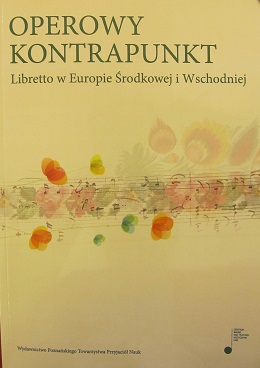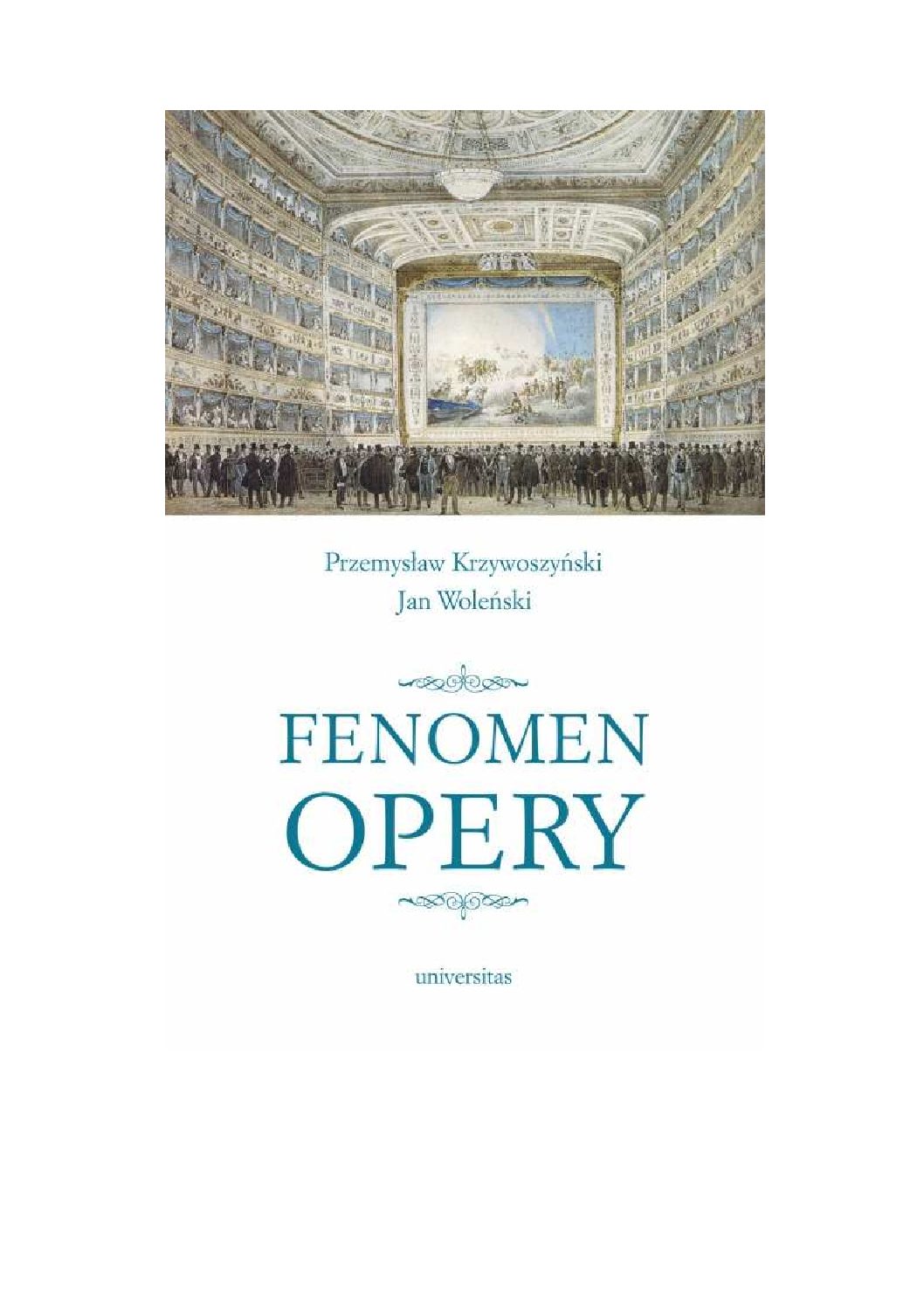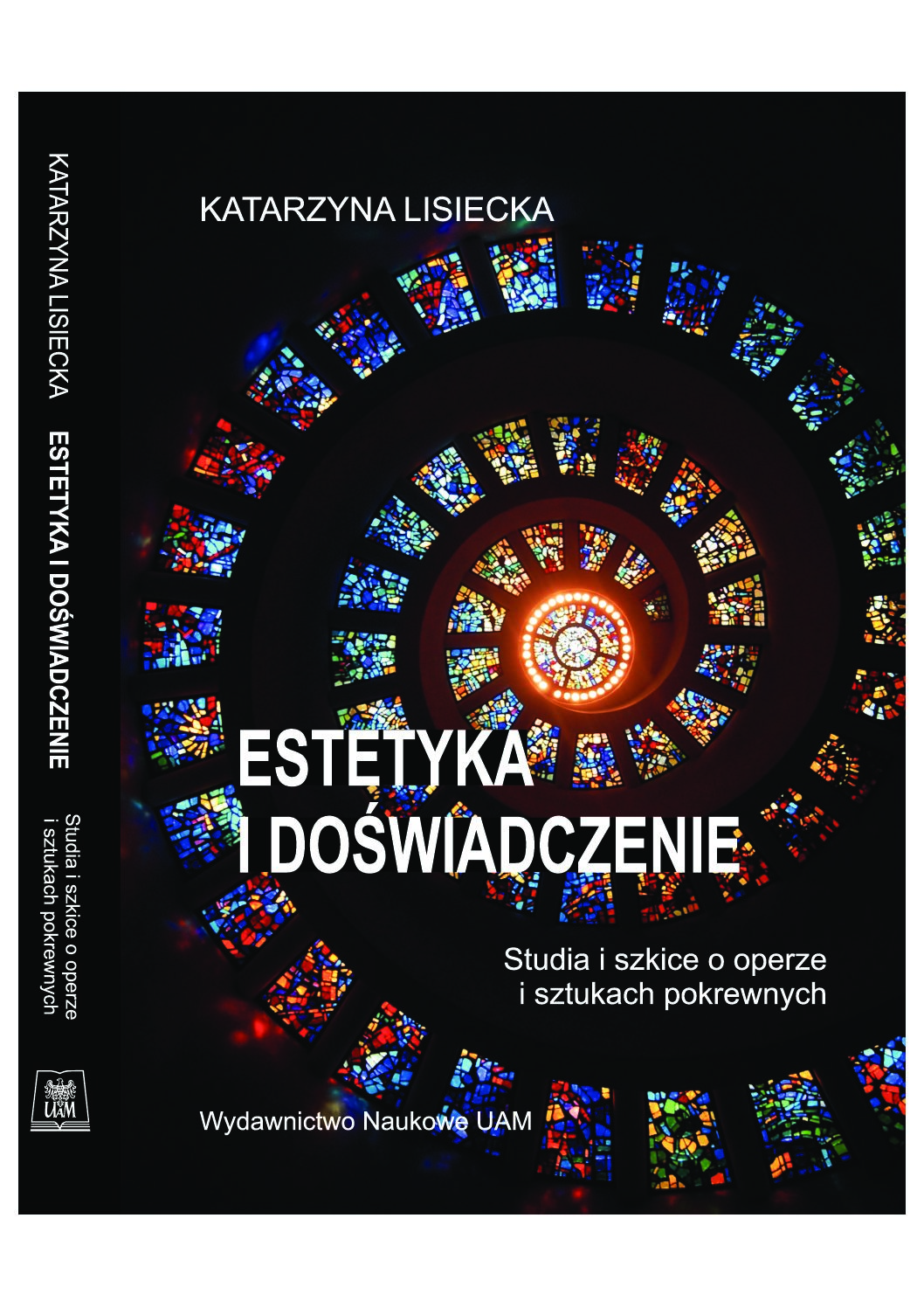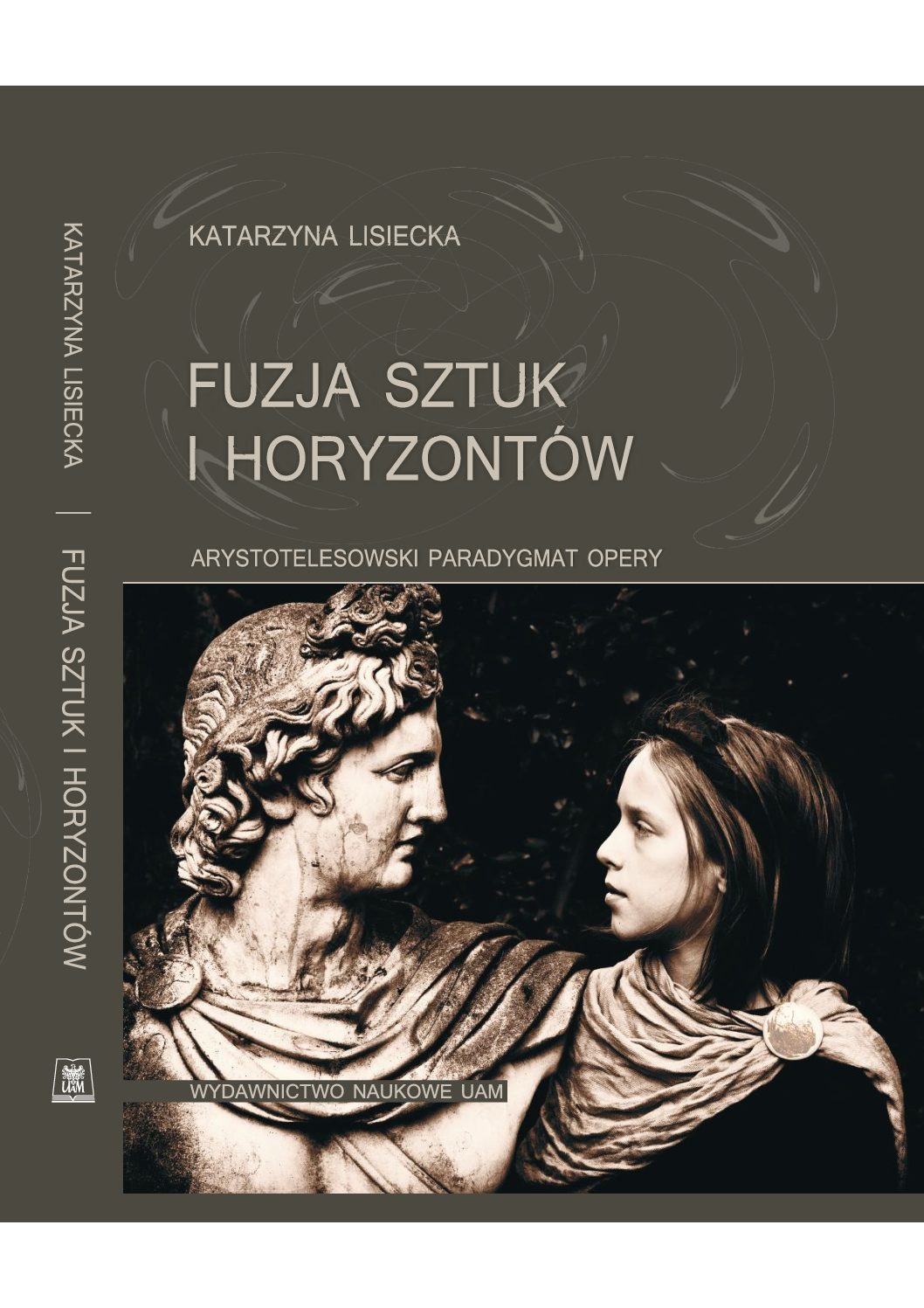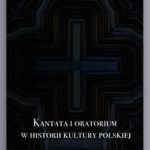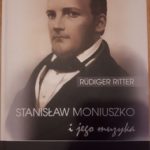13 - 02
2015
Operowy kontrapunkt. Libretto w Europie Środkowej i Wschodniej, pod. red. Barbary Judkowiak i Katarzyny Lisieckiej, Wydawnictwo PTPN, Poznań 2014
Spis treści
Wprowadzenie
I. Swojskość – obcość
Anna Ryszka-Komarnicka, „In tempore belli et pacis”: warszawska Giuditta (1635) w świetle wybranych włoskich drammi sacri i oratoriów z XVII–XVIII wieku
Aneta Markuszewska, Motyw Ifigenii w operze XVIII wieku. Kontekst polski
Małgorzata Sokalska, W poszukiwaniu egzotyki. „Swojskość” i „obcość” w polskich librettach operowych
Anna Wypych-Gawrońska, Stara baśń Władysława Żeleńskiego i Aleksandra Bandrowskiego. Między Słowiańszczyzną a wagneryzmem
Natalia Rusiecka, „Opera Europy” Franciszki Urszuli Radziwiłłowej
II. Motywy – idee przewodnie a libretto
Alina Żórawska-Witkowska, Lud, naród i ojczyzna w pierwszych operach polskich (1778–1794)
Rüdiger Ritter, Czy istnieje wzór dla libretta opery narodowej? Kilka rozważań na przykładzie opery polskiej
Iwona Puchalska, Zabobon w polskiej twórczości operowej – od Bogusławskiego do Pendereckiego
Beata Kornatowska, Metamorfozy Ondyny. Między literaturą a operą
Michał Bajer, Tragiczne wahanie. Casus struktury dramaturgicznej w Halce Wolskiego i Moniuszki
Swiatłana Niemahaj, Zaginione opery i operetki Stanisława Moniuszki do librett Wincentego Dunina-Marcinkiewicza: kształt, losy, wątpliwości
III. Libretto – inscenizacja
Agnieszka Kosmecka, Libretto zapomnianego dzieła. Bunt żaków Brandstaettera – Szeligowskiego
Joanna Maleszyńska, Polskie musicale wobec powieściowej tradycji literackiej. Rekonesans problematyki
Ferenc János Szabó, “Ein Tristan von nobelstem Stahl…”: The Influence of a Czech Wagner Tenor on Hungarian Musical Life in the First Half of the Twentieth Century
Lauma Mellēna-Bartkeviča, Re-extending Wagner’s Universe: the 21st Century Ring in the Latvian National Opera
Noty o autorach
Indeks osób
Anna Ryszka-Komarnicka, “In tempore belli et pacis”: Warsaw Giuditta (1635) in the Light of the Selected Italian drammi sacri and Oratorios from the 17th-18th Centuries
The present article is a continuation of studies into the so-called Warsaw Giuditta, i.e., dramma sacro performed in 1635 as part of the patronage of the King Władysław IV Vasa. The studies started with the work “Between Literary Tradition and Patriotic War: the Warsaw Giuditta” (1635) [in print], which concentrated on the analysis of this work in the context of an earlier tradition of spoken dramas from circa 1700 and the first operas based on The Book of Judith. However, some dramaturgic solutions proposed by an anonymous librettist of the Warsaw spectacle, very original for the period of the work’s creation (among others, an ascetic portrait of Judith, the murder of Holophernes being perpetrated
on stage, the role of the prisoner from Bethulia allowing for an allegorical interpretation of the opera as a recollection of the king’s relieving of a besieged town, owing to which the besieged Smolensk was freed during the Polish-Russian war [1632–34]) proved to be more in line with the trends observable in subsequent Italian dramas (for example, by Filocala Caputa or Giulio Cesare Sorrentino), drammi sacri per musica (Sebastian Baldini or Filippo Tomassini) and numerous oratorios from the second half of the 17th century and the beginning of the 18th century.
Aneta Markuszewska, The Motif of Iphigenia in the 18th-century opera. The Polish context
The motif of Iphigenia sacrificed at the altar of goddess Diana by her father Agamemnon, the commander of the greek army during the Trojan War is well known in the Western culture primarily through contact with Antique sources (mythology, greek drama, especially the dramas of Euripides). The sacrifice of Iphigenia was supposed to bring the greeks a favourable wind that would allow them to leave the port in Aulis and sail to Troy for their victory. The story of Iphigenia became a source of inspiration for many poets of the early modern era (Shakespeare, P. Corneille, Racine, goethe), and also for numerous eighteen-century librettists (C.S. Capece, A. Zeno, B. Pasqualigo, P. Rolli, L. de Villati, m. Coltellini)
and composers (D. Scarlatti, A. Caldara, T. Traetta, Ch. W. gluck, A. y Soler). This article presents an early history of the use of the myth of Iphigenia in the history of opera, focusing on the portrayal of changes which were introduced on the basis of the operatic libretto at the beginning of the 18th century on the example of dramma per musica Ifigenia, staged in Venice in 1707 and Ifigenia in Aulide , presented in Vienna in 1718. The second question discussed by the article is the demonstration of the Polish context of the librettos which made Iphigenia the leading heroine. In 1713 Polish queen Marie-Casimire de la grange d’Arquien staged several operas devoted to the daughter of Agamemnon
(Ifigenia in Aulide and Ifigenia in Tauri) in her private theatre in Palazzo Zuccari in Rome. The author of both librettos was a poet and queen’s secretary Carlo Sigismondo Capece, the music was composed by the queen’s maestro di cappella Domenico Scarlatti. The aim of this article is to demonstrate in what way the history of Iphigenia served marie-Casimire to present the fate of her own family, simultaneously making it a part of the contemporary political context.
Małgorzata Sokalska, In search of the Exotic. “sameness” and “otherness” in Polish operatic Librettos
Polish librettos are rarely set in exotic, foreign surroundings or make use of characters that are ethnically alien, although such topics were considered important in the western opera, especially in the 18th and 19th centuries. most characteristic examples of the adoption of such motifs in Polish operatic compositions are the librettos written by Jan Chęciński for the opera Paria by Stanisław moniuszko and Alfred Nossig (in the translation of Stanisław Rossowski) for Manru by Ignacy Jan Paderewski, both based on the literary originals (the tragedy by C. Delavigne and the novel by J.I. Kraszewski). The article focuses on the selected aspects of the adaptation of the literary sources in librettos and the social issues
discussed in them (caste inequality and ethnic intolerance), which allows the audience to discern clear divisions for “one’s own” and “others” among the protagonists. This distinction appears to be essential for the interpretation of the conflict constituting the axis of action in both librettos.
Anna Wypych-Gawrońska, Stara baśń (“An Ancient Tale”) of władysław Żeleński and Aleksander Bandrowski. between slavdom and wagnerism
Stara baśń (“An Ancient Tale”) of Władysław Żeleński and Aleksander Bandrowski belongs to the operas which, when considering their theatrical reception, remain today mainly a historical phenomenon. However, due to its theatrical and critical reception in the beginning of the 20th century, the opera is an interesting example of the ideological and esthetical thinking of its times, also owing to the fact that it constitutes a proof of interpreting this work through two categories belonging substantially to different worldviews. Slavdom is predominantly a cultural and ideological category whereas Wagnerism – mainly an esthetical one. In the opera by Żeleński and Bandrowski, or more precisely in the reception of this
opera, these two categories met and the present article is devoted to the critical reception of this encounter.
Natalia Rusiecka, The opera of the Europe by Franciszka Urszula Radziwiłłowa
The present article is devoted to the dramatic works by Franciszka Urszula Radziwiłłowa which were presented on the stages of Belorussian theatres. Particularly, it focuses on Europe’s Opera which is a part of a larger theatrical project entitled. Abduction of Europe or the Theatre of Urszula Radziwiłłowa (Nesvizh Harlequinade). Apart from its operatic part, the performance is composed of a ballet based on the drama Miłość dowcipna and the comedy Niecnota w sidłach. The premiere of the play took place in minsk (Belorussia) on April 22, 2011 on the stage of The Janka Kupała National Academic Theatre. It was directed by Mikołaj Pinihin. The ballet libretto and the stage adaptation of all parts of the play was
prepared by a dramatist Siarhiej Kawalou. The translation of the dramas by Radziwiłłowa and the aria of Harlequin has been made by the author of this article. The entire music for the performance The Theatre of Urszula Radziwiłłowa was written by Andrzej Zubrycz as the score for the 18th-century operatic libretto had not been preserved. The choreography by Natalia Furman, scenography and costumes by Wolhi mackiewicz. Scholarly consultation – Wiktor Skorabahatau. The students of the choreographic schools in Minsk participate in the ballet part of the performance. The comedy and the opera are performed by the actors of The Janka Kupała National Academic Theatre.
Alina Żórawska-Witkowska, People, nation and Motherland in the First Polish operas (1778–1794)
The concepts mentioned in the title found strong reflection in the librettos of the first Polish operas. The accompanying music had to be in agreement with the ideas expressed in them. However, the music has survived in just some cases. At that time, the opera referred to by scholars as the rural opera gained special popularity in Poland. The action of such a composition, set in the countryside, provided a pretext for the introduction of a detailed presentation of the then realities in the literary, musical and staging layers. King Stanisław August Poniatowski, a patron of the Warsaw theatre, not only promoted the creation of the first Polish opera presented publically ( Nędza uszczęśliwiona, Franciszek Bohomolec and
Wojciech Bogusławski – Maciej Kamieński, Warsaw 1778), but also supported the Enlightenment ideas presented in the following works, connected with the improvement of the social condition of the people serving their lords, and enlivened with music stylized for rural, which plays major role in the operas Zośka, czyli Wiejskie zaloty (Stanisław Szymański – Maciej Kamieński, Warsaw 1779) and Cud albo Krakowiacy i Górale (“The miracle, orKrakovians and Highlanders”) (Wojciech Bogusławski – Jan Stefani, Warsaw 1794). Thelibrettos of the mentioned operas surprise the audience with their moral realism and social radicalism, enhanced in the musical layer by drawing upon folk sources. moreover, the
Polish opera is affected by the idea of motherland, whose most distinct example is Matka Spartanka (Franciszek Dionizy Kniaźnin – Wincenty Lessel, Puławy 1786), staged at the court of the Czartoryski ducal family, to which the king responded with Kantata w dzień inauguracji statui króla Jana III (Adam Naruszewicz – Maciej Kamieński, Warsaw 1788). As we can see, already in the operatic compositions created during the reign of Stanisław August Poniatowski we can find the ideals and musical means which would become a foundation of the Polish national opera in the 19th century.
Rüdiger Ritter, Gibt es ein Modell für das Libretto einer nationaloper? Einige Überlegungen am beispiel der polnischen oper
Die deutsche Sprache kennt den Unterschied zwischen nationaler Oper und Nationaloper. Eine nationale Oper thematisiert den nationalen gedanken in herausragender Weise, eine Nationaloper hingegen ist durch eine charakteristische Symbolfunktion gekennzeichnet, dessen Wirksamkeit über die musikalische interessierten Kreise weit hinausgeht und gesamtgesellschaftliche Bedeutung hat. Die Kategorie Nationaloper ist eine Rezeptionskategorie, d. h. über den Charakter eines Werks als Nationaloper entscheiden weniger werkimmanente Kriterien, als vielmehr der Verlauf der Rezeption des Werks. Auch wenn es in der polnischen Sprache diese Unterschiede nicht gibt, so wurde doch in der polnischen
Operngeschichte intensiv gerade über diese Problem nachgedacht. Seit Ende des 18. Jahrhunderts führte eine intensive Diskussion über die grundsätzliche möglichkeit einer Oper in polnischer Sprache zur Komposition einer Vielzahl von nationalen Opern. Aus dieser Vielzahl hoben sich jedoch nur einige wenige Werke hervor, die den Rang von Nationalopern beanspruchten, nämlich zunächst Krakowiaki i Górale und dann vor allem Moniuszkos Halka. ganz augenscheinlich folgen die polnischen Entwicklungen hier einem bestimmten muster, nach dem europaweit Nationalopern entstanden. Dennoch läßt sich
die Entwicklung nicht in ein einfaches Schema pressen, da die Entwicklung des Librettos als auch der musik sowohl von landestypischen Tradition als auch von gattungsbedingten Vorgaben abhängt. So wurden zu Nationalopern beispielsweise sowohl Werke aus dem Bereich der historischen Oper als auch aus dem Bereich der sog. Rettungsoper oder des grand opéra. Die am Eingang des Beitrags gestellte Frage nach gesetzmäßigkeiten der Entstehung von nationalen Opern und Opernlibretti muss also verneint werden, wohl aber gibt es stilistische grundmuster, die die Vielzahl der Nationalopern in vielerlei Hinsicht vergleichbar machen.
Iwona Puchalska, Superstition in Polish operatic works – from Bogusławski to Penderecki
The text is an attempt at a comprehensive presentation of the motif of superstition (in the religious understanding of this notion) observable in the texts of Polish librettos from the origins of the musical theatre in Poland during the Enlightenment, when superstition was subjected to a rational unmasking, but at the same time was considered a very important incentive of human action (and consequently – the dramatic action), through a fundamental change in the attitude toward superstition during Romanticism, until the modern times. The evolution of the treatment of superstition has been portrayed on the example of Cud albo Krakowiaki i Górale (“The Presumed miracle, or Krakovians and Highlanders”)
by Wojciech Bogusławski, Szarlatan czyli wskrzeszenie umarłych by Alojzy Żółkowski, Dziady (“Forefathers”) part IV by Adam Mickiewicz, Straszny dwór (“The Haunted manor”) by Jan Chęciński and Diabły z Loudun (“The Devils of Loudun”) by Krzysztof Penderecki.
Beata Kornatowska, Metamorphoses of Undine. Between Literature and opera
The story Undine by Friedrich de la Motte Fouqué from 1811, belonging to the classics of german literature, has inspired creators since the early Romanticism up to the contemporary times. Numerous literary works, several operas as well as a few ballets have been based on this story. The article is devoted to the journey of the motif of Undine – one, along with Lorelei, of the main nymphs of the german Romanticism. The author commences with studying the motif’s genealogy – the so-called nature papers of Paracelsus, which Fouqué drew upon, through the literary and musical works of popular culture from the 19th century, owing to which the motif entered permanently the repertoire of the
Romantic art, and finally operas inspired by Fouqué’s story, namely E.T.A. by Hoffmann, Albert Lortzing and Antonin Dvořák.
Michał Bajer, Tragic Hesitance. The case of the dramatic structure in Halka by Wolski and Moniuszko
The paper deals with the analysis and description of an excerpt from the opera Halka, focusing on its dramatic structure and its literary and theatrical antecedences. The scene discussed in the paper is the scene in which Halka, standing in front of the church, participates in a wedding ceremony. The analysis refers to the European tragic tradition (form the Antiquity to the Romantic period). The first part of the paper relates to visual signs used by the author of the libretto. The torch held by Halka associates her with traditional representations of greek goddesses of revenge, whereas the position of the dissonance
element on the peripheries of a wedding ceremony, indicates an analogy with the situation of medea in tragedies of Euripides and Seneca. The next part of the study refers to the linguistic structure of the scene, focusing on its connections with dilemma-based classicistic monologues. The subsequent parts relate to the position of the described scene in the structure of the whole opera. moreover, the analogies between the elements of Wolski’s text and the specific examples of tragedies and Romantic operas are thoroughly examined. The last part describes a specific manner in which Wolski treated the conventional tragic elements. The most prominent features include a linguistic reduction of the scene structure, an emphasis put on the identity crisis of the main heroine as well as an establishment of a special – based on a specific distance – relationship with the audience.
Swietłana Niemahaj, Lost operas and operettas by stanisław Moniuszko with the Librettos of Wincenty Dunin-Marcinkiewicz: structure, Fortunes, doubts
The article concentrates on four theatrical plays from 1840–50, connected with the minsk stage: Pobór rekrutów (“Conscription”), Walka muzyków (“The musicians’ Struggle”), Cudowna woda (“The miraculous Water”) and Sielanka (“Idyll”). Although research tradition ascribes them all to the collaboration between Stanisław moniuszko and a Polish-Byelo-russian playwright Vintsent Dunin-martsinkyevich, however, besides Sielanka (“Idyll”), this opinion has not been documentarily confirmed. Unsolved problems regarding the authorship, as well as their complicated history and disappearance of the textual and musical material of the majority of these plays result in only approximate concept of the form of these works. Only the preserved libretto and a musical excerpt from Sielanka render it possible to reconstruct partially an image of this unique bilingual opera: its poetics, stylistic roots, genre attributes or even the sound of some crucial scenes. Undoubtedly, all discussed works were characteristic examples of stage plays both from the eastern borderlands of the Polish Commonwealth as well as from the Russian Empire, where, in the times of Moniuszko’s youth, the comic opera dominated, being under a considerable influence of vaudeville. On the other hand, these plays – following the local theatrical traditions and showing some originality in the sphere of their subject matter, esthetics and linguistic
elaboration – were also testimonies of the tendencies leading to the origin of a new form of the national theatrical culture.
Agnieszka Kosmecka, The Libretto of a Forgotten opera. Bunt żaków (“The schoolboys’ Revolt”) by Brandstaetter and Szeligowski
The presented paper constitutes an attempt at examining the complicated history of Bunt żaków (“The Schoolboys’ Revolt”) – one of the Polish contemporary operas, a joint production of Roman Brandstaetter and Tadeusz Szeligowski. The process of its creation was observed by the most important representatives of the political world. It was supposed to be the grandest accomplishment of the new government in the field of culture. The idea was to reinstate this splendid, yet forgotten, genre onto the stages of Polish opera theatres. The premiere was spectacular – Bunt żaków was a tremen-dous success. It was performed in numerous places, even abroad. However, at the very moment of its birth the opera began to die slowly. The spectacle failed to resist time; it did not delight the audience – even if it was staged, it quickly disappeared from the repertoire.
Joanna Maleszyńska, Musical Libretto and Literature. Examining the Problem
The article is an attempt to examine the phenomenon which has not been dealt with in research papers: to what extent the modern authors of musicals draw upon the classical literary works, writing the librettos on their basis, thus making their stage adaptations? What kind of literature do they use? How do they alter literature for the needs of songs which constitute the main form of communication during the performance? What is the source of popularity of the musicals based on the masterpieces of European literature? And finally – how do the musical versions of the dramas by William Shakespeare and the epos by Victor Hugo benefit by having a “soundtrack” composed for them? Does a musical, due to its specific features, unavoidably lowers the tone of high literature or otherwise – by artistic shortening verifies its values and infuses new life into literature which is outstanding but neglected by readers? This paper is thus an initial research attempt, whose intention is to direct attention to a new phenomenon, observable on the musical stage from just several decades.
Ferenc Janos Szabó, „Ein Tristan von nobelstem stahl…”: wpływ czeskiego tenora wagnerowskiego na węgierskie życie muzyczne w pierwszej połowie XX wieku
1. Karel Burian na Węgrzech
Karel Burian był jednym z najlepszych wagnerowskich tenorów na początku XX wieku. Jak twierdzą Gustav Mahler i Karl Böhm, był to najlepszy Tristan ich czasów. Autorzy biografii tego artysty zawsze wspominają jego wagnerowskie role i długą obecność na scenach Nowego Yorku, a przede wszystkim światową premierę Salome Ryszarda Straussa, w której śpiewał partie Heroda, i która dała mu wielki rozgłos. Jego sława i popularność mogły być porównywane jedynie do tych, którymi cieszył się Enrico Caruso. Burian był obecny w muzycznym życiu Budapesztu niemal bez przerwy od 1900 do 1923 roku. Był centralną postacią zwłaszcza w kręgach miłośników muzyki Wagnera. Miał on ogromne wpływy na Węgrzech, nie tylko w świecie opery, ale także na gruncie szeroko pojętej kultury muzycznej. W latach 1901–1902 był członkiem Węgierskiej Opery Królewskiej. Oprócz ról wagnerowskich we wspominanym sezonie teatralnym śpiewał w trzech węgierskich premierach, pojawił się jako Lenski w Onieginie Czajkowskiego, jako Loris Ipanoff w Fedorze Umberto Giordano, a w listopadzie 1901 roku jako Tristan w Tristanie i Izoldzie Wagnera. W 1902 roku Burian zerwał kontrakt i dopiero w 1907 roku powrócił
do Budapesztu. Był już wówczas sławnym śpiewakiem i od tej pory regularnie występował gościnnie na scenach stolicy. Jego obecność umożliwiła wystawianie wagnerowskiego repertuaru w Węgierskiej Operze Narodowej. W 1913 roku przyjął obywatelstwo węgierskie. Mniej znanym faktem jest, że aż do swej śmierci dawał w Budapeszcie szacunkowo 30 do 40 przedstawień rocznie. Zaśpiewał również w światowej premierze opery węgierskiej Otello mesél [Otello opowiada] Jenő Sztojanovitsa.
2. Burian i repertuar słowiański w Budapeszcie
Burian, jako śpiewak, wydawca nut i tłumacz librett operowych, był entuzjastycznym propagatorem muzyki swej ojczyzny. Często wykonywał czeskie pieśni na koncertach także w Budapeszcie, a większość z nich była prezentowana na Węgrzech po raz pierwszy. Choć śpiewał niektóre arie z Dalibora czy Hubička na koncertach w stolicy, ze swych słowiańskich ról na Węgrzech miał okazję prezentować jedynie Lenskiego. W drugiej części artykułu pokrótce podjęte zostały rozważania na temat recepcji słowiańskiej opery na Węgrzech między rokiem 1893 (Prodaná nevĕsta) a 1909 (Dalibor). Omówiono także gościnne występy czeskiego zespołu operowego w Budapeszcie w kwietniu 1902 roku. Burian nagrał wiele słowiańskich pieśni i partii operowych. Zanalizowano jego nagranie arii Lenskiego w zestawieniu z doniesieniami węgierskiej prasy na temat jego występów w tej roli w Budapeszcie oraz w porównaniu z nagraniami współczesnych mu śpiewaków Johannes’a Sembacha i Alexandra Kirchnera. Słowiański repertuar Buriana nie miał jednak dużego wpływu na ogólną muzyczną kulturę Budapesztu.
3. Wpływ Karela Buriana na węgierską kulturę muzyczną
W części trzeciej omówiono wpływ Buriana na węgierską kulturę muzyczną w kontekście kultu muzyki Wagnera panującego wśród generacji Béli Bartóka i Zoltána Kodály’a. Na przełomie wieków kulturalne życie Budapesztu było oparte na tym co niemieckie: Wagner wpływał najsilniej na młodych kompozytorów w ich latach szkolnych, bez względu na to czy spoglądali na niego jak na ideał, czy uważali, iż jest przykładem tego, jak nie należy pisać muzyki. Obydwaj Bartók i Kodály odwiedzili w roku 1904 Bayreuth i ich wczesne kompozycje pozostawały pod wpływem muzyki Wagnera, co w sposób oczywisty jest związane z wagnerowskimi wykonaniami Karela Buriana. Jako ilustrację zagadnienia zanalizowano
Adagio na skrzypce i fortepian Zoltána Kodály’a (1905), który to utwór nosi wyraźne ślady wpływu mistrza z Bayreuth a konkretnie jego Tristana i Izoldy.
4. Wpływ Buriana na kulturę operową Budapesztu
Burian miał także wpływ na wiele aspektów kultury operowej w Budapeszcie. Nie tylko dlatego, że reprezentował najwyższy standard śpiewu, ale też dlatego że sukces premiery Tristana i Izoldy stał się wydarzeniem przełomowym. Styl śpiewaczy Buriana i jego artystyczna jakość były opisywane przez krytyków w Budapeszcie jako „styl Bayreuth”. Choć nie możemy wiedzieć, co dla krytyków kryło się pod tym określeniem, wydaje się, że używali go, gdy spodobała im się jakaś realizacja Wagnera. Co więcej, w Bayreuth wystąpił Burian tylko raz, i to ze skromnym sukcesem. Jak twierdzi wielu autorów, styl śpiewania oper Wagneraprzeszedł znaczącą przemianę po śmierci kompozytora. Za życia Cosimy Wagner nacisk został przeniesiony z muzyki na tekst dramatu, większe znaczenie przywiązywano do recytatywów niż do belcanto. Legato śpiewano tylko w sekcjach arioso, portamento dozwolone było bardzo rzadko i tylko gdy istniał ku temu dobry powód. Wierne odśpiewanie nut było jednym z najważniejszych wymogów. W artykule zaprezentowano tę stylistyczną różnicę za pomocą zestawienia nagrań Wagnera w wykonaniu Karela Buriana i Ernsta Krausa. Burian był pierwszym heroicznym tenorem w Budapeszcie, który śpiewał w Węgierskiej Operze Królewskiej od swej młodości do śmierci. Wszyscy kolejni tenorzy wagnerowscy w tej instytucji byli z nim porównywani. Jego śpiew stał się najwyższym standardem,
choć nie pod każdym względem. Idealny tenor wagnerowski powinien był mieć nie tylko prawdziwie heroiczny głos, lecz sam powinien był być postacią heroiczną. Co więcej, powinien był być – jak twierdzono – Węgrem. Wpływ Buriana na tenorów węgierskich można najlepiej zbadać wykorzystując nagrania Zsigmonda Pilinszky’ego i Zoltána Závodszky’ego. Zsigmond Pilinszky debiutował w 1913 roku w Węgierskiej Operze Królewskiej. Zaledwie rok później zaśpiewał rolę Eryka w Latającym Holendrze. Swój repertuar wagnerowski wzbogacił później partiami Zygmunta i Lohengrina, a w późnych latach dwudziestych Tannhäusera i Zygfryda. Słysząc go wykonującego role wagnerowskie, krytycy podkreślali, że jest bardzo obiecujący, lecz ciągle musi się wiele nauczyć. Opuścił Operę w 1928 roku i przeniósł się do Berlina, następnie stał się dobrze znanym tenorem wagnerowskim. Zoltán Závodszky debiutował w 1920 roku w Budapeszcie. W latach 1925–1930 studiował i wykonywał z ogromnym powodzeniem wszystkie największe wagnerowskie role tenorów. Krytycy cenili jego deklamacje, wyczucie stylistyczne, ekspresyjność i dźwięczny głos. Sukces, jaki odniósł po swoim pierwszym Tristanie, jest nie do opisania. To było pierwsze przedstawienie tej opery w pełnej węgierskiej obsadzie i po węgiersku. Závodszky
był pierwszym członkiem Opery, który mógł właśnie po węgiersku zaśpiewać tę rolę. Był pierwszym rodzimym węgierskim tenorem, który wystąpił we wszystkich wagnerowskich rolach dla tenorów w Budapeszcie. Pilinszky był w stolicy Węgier zwykle mocno krytykowany, a Závodszky’ego ceniono
jako wagnerowskiego tenora. Ich nagrania jednakże wywierają inne wrażenie. W tej części studium pokazano różnice i podobieństwa w stylu śpiewaczym Buriana, Pilinszky’ego i Závodszky’ego na podstawie porównania ich nagrań arii „mein lieber Schwan” z Lohengrina. Styl śpiewaczy Buriana był typowym stylem tenora bohaterskiego z wieloma elementami belcanto. Obydwaj, Pilinszky i Závodszky stosowali rozwiązania typowe dla belcanto (portamento, fermaty). Podczas gdy Pilinszky miał czysty głos tenora bohaterskiego, to śpiew Závodszky’ego charakteryzował słodszy, niemal liryczny styl. Pod koniec czwartego rozdziału podjęto próbę odpowiedzi na pytanie dlaczego budapesztańska prasa zdawała
się preferować Závodszky’ego jako tenora wagnerowskiego i dlaczego odgrywał role wagnerowskich bohaterów w inny sposób. Niemniej, jak pokazują recenzje prasowe, wpływ Karela Buriana był fundamentalny w pierwszej połowie XX wieku w Budapeszcie. Po jego śmierci pamięć o nim stanowiła miarę, którą mierzono innych wielkich śpiewaków.
Lauma Mellēna -Bartkeviča, Przedłużenie wagnerowskiego wszechświata: XXI-wieczny „pierścień” w Łotewskiej Operze Narodowej
Świętując dwusetlecie urodzin Ryszarda Wagnera, w czasie ostatniej dekady Łotewska Opera Narodowa realizowała projekt rocznicowy – prezentację pełnego cyklu „Pierścienia Nibelunga” w międzynarodowej obsadzie i pod kierunkiem dwóch młodych i ambitnych reżyserów Stefana Herheima (Norwegia/Niemcy) i Viestursa Kairišs’a (Łotwa). Ta kombinacja w ciekawy sposób nawiązuje do struktury cyklu Wagnera – Wigilii (niem. Vorabend) i trzech dni symbolicznej refleksji na temat bogów, ludzkości, siły, miłości,
chciwości i przemocy. Koncepcje postmodernistyczne i model teatru reżyserskiego, które wkraczają na sceny operowe w XXI wieku, stwarzając dodatkowe warstwy znaczeniowe reprezentujące współczesne realia socjologiczno-kulturowe i powiązane z nimi symbole, kontekstualizują oryginalną opowieść i intencjonalnie przybliżają ją dzisiejszemu odbiorcy. Artykuł analizuje strategie zastosowane przez reżyserów w interpretacji cyklu Wagnera i określa wkład Łotewskiej Opery Narodowej w artystyczną próbę przedłużenia Wagnerowskiego wszechświata po miasto, w którym kompozytor niegdyś żył, co stanowi część tzw. peryferyjnych studiów nad Wagnerem oraz wskrzesza tradycje opery wagnerowskiej w Rydze. Abstrahując od tego, że cały cykl „Pierścienia” został ostatnio, w 2013 roku, nagrodzony Wielką Łotewską Nagrodą muzyczną jako „Najwybitniejszy europejski projekt muzyczny roku na Łotwie”, dowiódł on, że nawet mały teatr operowy o bardzo ograniczonym budżecie jest w stanie poradzić sobie z tak fundamentalnym dziełem jak Wagnerowska tetralogia i dać mu międzynarodowy wydźwięk. Bezpośrednim rezultatem projektu było podniesienie „wagnerowskiej świadomości” wśród publiczności łotewskiej, poprawa i rozwój umiejętności łotewskich śpiewaków i muzyków orkiestrowych, co mogło
znacznie przyśpieszyć dalszą międzynarodową karierę wielu artystów, takich jak obecnie światowej sławy dyrygent łotewski Andris Nelson, kilku lokalnych śpiewaków oraz reżyserów, takich jak Stefan Herheim, który stał się znaczącą postacią dla dzisiejszych realizacji Wagnera w Europie, oraz Viesturs Kairišs, który rozpoczął międzynarodową karierę reżyserską w 2013 roku. Autorka analizuje w artykule wszystkie cztery opery cyklu w realizacji Łotewskiej Opery Narodowej jako próbę podkreślenia ponadczasowości i uniwersalności oryginalnego libretta przez dodanie nowych kontekstów nawiązujących do socjologiczno-historycznych podstaw współczesnego społeczeństwa, które wpływają dziś na odbiór dzieła Wagnera. Główną tendencją zaobserwowaną w postmodernistycznej realizacji wystawionego w Rydze „Pierścienia” jest próba rozszerzenia kontekstu oryginalnego Wagnerowskiego libretta, odsłonięcia odmiennego socjologiczno-historycznego tła i odniesienia się do znaczących zwrotów historii od czasów Wagnera po teraźniejszość, włączenia symbolicznych nawiązań do życiorysu Wagnera, współczesności i niesławnego wykorzystywania jego muzyki przez Hitlera, które nie pozostało bez wpływu na dzisiejszą recepcję jego dzieł i które skutkuje mnożeniem stereotypów na temat samego autora („Złoto Renu”). Ważne okazało
się także wyrażenie uniwersalnych idei relacji siły – miłości – przemocy, zawartych w libretcie wyraźnie opartym na XIX-wiecznym romantyzmie, oraz powiązanie ich z postmodernistycznym światem, co prowadziło do odkrycia różnych aspektów pamięci zbiorowej i konsekwencji XX-wiecznych wydarzeń historycznych oraz ich okoliczności dla dzisiejszego społeczeństwa („Walkiria”, „Zygfryd”, „Zmierzch bogów”). Reżyserzy rekontekstualizują wagnerowski symboliczny model świata i społeczeństwa w XXI wieku, próbują zinterpretować jego przesłanie i symbole przez teraźniejszość oraz dodać własne przesłanie przejawiające się w dialogu z autorem i jego dziełem. Libretto nie zostało zmienione, ale
pole zawartych w nim znaczeń stało się ponadczasowe przez dodanie odniesień i symboli znanych współczesnemu odbiorcy, które nie mogły być przewidziane przez Wagnera, mimo jego wizjonerskiej natury i aspiracji do tworzenia sztuki przyszłości. W XXI wieku życie z pewnością toczy się pod znakiem liberalizmu, bez określonego i bezpiecznego systemu wartości, włączając wartości kulturalne, oraz rutynę, która zwycięża nad światem idei bliskich Wagnerowi. Należał on bowiem do tej epoki w sztuce, która budziła emocjonalną część natury człowieka, by mógł on znieść XIX-wieczne, w pełni racjonalne i technokratyczne życie. W XXI wieku istotne jest pytanie o odpowiedzialność, pytanie: „Kto weźmie odpowiedzialność za przyszłość?” W scenie finałowej nie ma powodzi, płomieni, apokalipsy, tylko chór stoi i śpiewa niemy hymn… Viesturs Kairišs w swoim „Zmierzchu bogów” otwiera Wagnera na teraźniejszość, pokazując nowe wymiary jego symbolicznego dramatu muzycznego, odpowiadając w szerokim rozumieniu na zbiorowe traumy i groteskę dzisiejszej rzeczywistości. Postmodernistyczne realizacje, przynajmniej
te przedstawiane w Rydze, są próbą ucieleśnienia tego, czego częścią był Wagner – obudzenia świadomości współczesnych, by zainspirować ich do zmiany świata na lepsze przez sztukę i umożliwić nam przemyślenie tego, co uczyniło nas takimi, jakimi jesteśmy dzisiaj.


